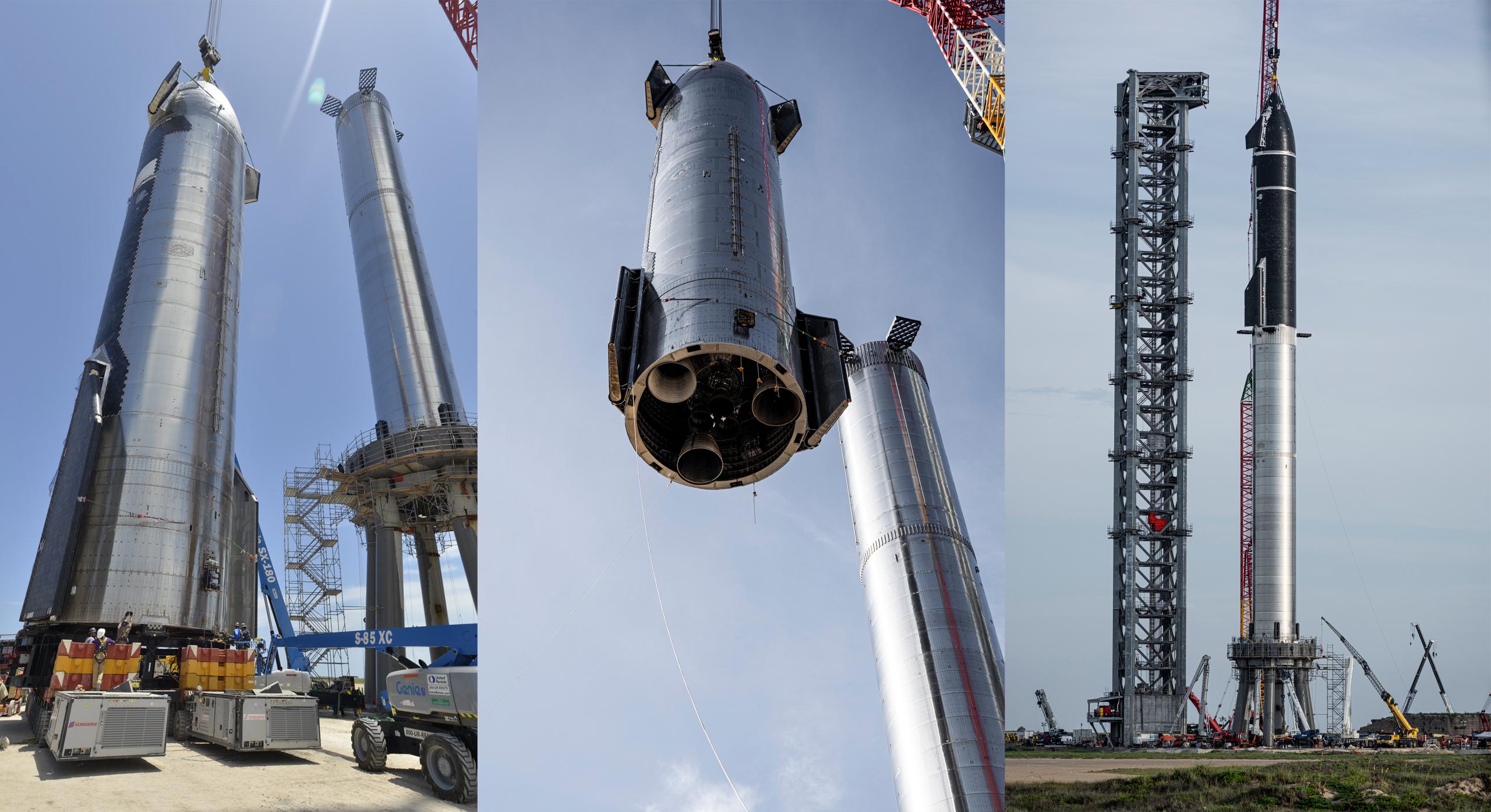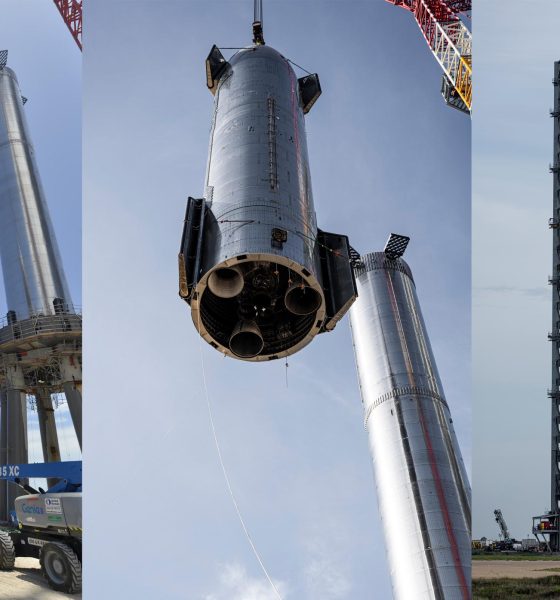

News
SpaceX CEO Elon Musk promises long-awaited Starship update next week
While running behind schedule in classic fashion, SpaceX CEO Elon Musk says he’ll present the first big Starship program update in two and a half years on Thursday, February 10th.
Additionally, as an apparent centerpiece for the event and update, Musk says that SpaceX will perform the second-ever “full stack” fit test with a Starship upper stage and Super Heavy booster.
Starship S20 and Super Heavy booster B4 were stacked for the first time in early August 2021, when both stages were still weeks or even months away from some degree of completion. Only months later did Starship S20 kick off a multi-month period of qualification tests, eventually becoming the first Starship prototype to successfully test a full six Raptor engines at once. Super Heavy B4, on the other hand, had an even more painful time for unknown reasons and only graduated to basic cryogenic proof testing in mid-December – more than four months later.
While the booster has had a full 29 Raptor 1 engines installed for months, the booster has yet to perform or attempt a single static fire of any number of those engines and hasn’t even managed a basic wet dress rehearsal with real liquid oxygen and methane propellant. Eventually, SpaceX did perform a handful of Booster 4 Raptor ignition tests, but those were almost more of a test of the launch pad than Super Heavy itself. The slow and minimal progress SpaceX has made testing Super Heavy B4 may actually be because of issues with orbital launch pad’s tank farm design. To this day, while the oxygen and nitrogen half of the farm are already storing thousands of tons of propellant and coolant, the fuel side of the same farm has yet to be filled with any methane. That makes thoroughly testing a Super Heavy booster much harder, though there are some obvious workarounds SpaceX could have made if it had really wanted to start proof testing Booster 4 as soon as possible.
In fact, it’s no longer clear if Ship 20 and Booster 4 will actually get to fulfill their original goal of supporting Starship’s first orbital (velocity) test flight. Nonetheless, they are still two giant, nearly completed stages that together form a full Starship ‘stack.’
Heading into 2022, SpaceX appears to be more focused on testing a somewhat extraneous part of the first orbital Starship launch site – “chopstick” arms installed on the launch tower. SpaceX’s current Starship ‘launch tower’ design centers around the need for three giant swinging arms – one to fuel and power Starship and the other two to lift, stack, and – maybe one day – catch Super Heavy boosters and ships. Had SpaceX stayed true to the original Starship/BFR/ITS design, the booster would have been fueled through the launch mount and Starship would have been fueled through a connection with the booster, significantly simplifying the tower.
In theory, replacing that design with a complex, building-sized umbilical arm might ultimately improve Starship’s nominal payload to orbit by a few percent. Additionally, using the even more complex “chopsticks” – a pair of giant arms – to lift and stack Super Heavy and Starship may actually be a smart design, as it could theoretically free SpaceX from the painful operational constraints imposed by large cranes.
By all appearances, that’s exactly what SpaceX plans to test next week. Starship S20 has already been moved adjacent to the launch tower and Super Heavy B4 has been attached to a crane (somewhat ironically) in preparation for its own move to the tower. For the first time, SpaceX might use the tower arms to lift Super Heavy onto the orbital launch mount, stabilize the booster, and then lift and stack Starship on top of it – all without a crane, in theory. Of course, insofar as SpaceX performed the first full-stack fit test with a crane, the tower’s lift/catch arms only really become irreplaceable once waiting a few days for safe lift conditions becomes a bottleneck for Starship launch operations.
Nonetheless, a successful stacking operation with those arms would be an impressive technical feat and demonstrate one of the things needed for all-weather Starship launch operations, even if it won’t leave SpaceX any closer to orbital test flights than it was before.

Elon Musk
Elon Musk’s X will start using a Tesla-like software update strategy
The initiative seems designed to accelerate updates to the social media platform, while maintaining maximum transparency.

Elon Musk’s social media platform X will adopt a Tesla-esque approach to software updates for its algorithm.
The initiative seems designed to accelerate updates to the social media platform, while maintaining maximum transparency.
X’s updates to its updates
As per Musk in a post on X, the social media company will be making a new algorithm to determine what organic and advertising posts are recommended to users. These updates would then be repeated every four weeks.
“We will make the new 𝕏 algorithm, including all code used to determine what organic and advertising posts are recommended to users, open source in 7 days. This will be repeated every 4 weeks, with comprehensive developer notes, to help you understand what changed,” Musk wrote in his post.
The initiative somewhat mirrors Tesla’s over-the-air update model, where vehicle software is regularly refined and pushed to users with detailed release notes. This should allow users to better understand the details of X’s every update and foster a healthy feedback loop for the social media platform.
xAI and X
X, formerly Twitter, has been acquired by Elon Musk’s artificial intelligence startup, xAI last year. Since then, xAI has seen a rapid rise in valuation. Following the company’s the company’s upsized $20 billion Series E funding round, estimates now suggest that xAI is worth tens about $230 to $235 billion. That’s several times larger than Tesla when Elon Musk received his controversial 2018 CEO Performance Award.
As per xAI, the Series E funding round attracted a diverse group of investors, including Valor Equity Partners, Stepstone Group, Fidelity Management & Research Company, Qatar Investment Authority, MGX, and Baron Capital Group, among others. Strategic partners NVIDIA and Cisco Investments also continued support for building the world’s largest GPU clusters.
News
Tesla FSD Supervised wins MotorTrend’s Best Driver Assistance Award
The decision marks a notable reversal for the publication from prior years, with judges citing major real-world improvements that pushed Tesla’s latest FSD software ahead of every competing ADAS system.

Tesla’s Full Self-Driving (Supervised) system has been named the best driver-assistance technology on the market, earning top honors at the 2026 MotorTrend Best Tech Awards.
The decision marks a notable reversal for the publication from prior years, with judges citing major real-world improvements that pushed Tesla’s latest FSD software ahead of every competing ADAS system. And it wasn’t even close.
MotorTrend reverses course
MotorTrend awarded Tesla FSD (Supervised) its 2026 Best Tech Driver Assistance title after extensive testing of the latest v14 software. The publication acknowledged that it had previously criticized earlier versions of FSD for erratic behavior and near-miss incidents, ultimately favoring rivals such as GM’s Super Cruise in earlier evaluations.
According to MotorTrend, the newest iteration of FSD resolved many of those shortcomings. Testers said v14 showed far smoother behavior in complex urban scenarios, including unprotected left turns, traffic circles, emergency vehicles, and dense city streets. While the system still requires constant driver supervision, judges concluded that no other advanced driver-assistance system currently matches its breadth of capability.
Unlike rival systems that rely on combinations of cameras, radar, lidar, and mapped highways, Tesla’s FSD operates using a camera-only approach and is capable of driving on city streets, rural roads, and freeways. MotorTrend stated that pure utility, the ability to handle nearly all road types, ultimately separated FSD from competitors like Ford BlueCruise, GM Super Cruise, and BMW’s Highway Assistant.
High cost and high capability
MotorTrend also addressed FSD’s pricing, which remains significantly higher than rival systems. Tesla currently charges $8,000 for a one-time purchase or $99 per month for a subscription, compared with far lower upfront and subscription costs from other automakers. The publication noted that the premium is justified given FSD’s unmatched scope and continuous software evolution.
Safety remained a central focus of the evaluation. While testers reported collision-free operation over thousands of miles, they noted ongoing concerns around FSD’s configurable driving modes, including options that allow aggressive driving and speeds beyond posted limits. MotorTrend emphasized that, like all Level 2 systems, FSD still depends on a fully attentive human driver at all times.
Despite those caveats, the publication concluded that Tesla’s rapid software progress fundamentally reshaped the competitive landscape. For drivers seeking the most capable hands-on driver-assistance system available today, MotorTrend concluded Tesla FSD (Supervised) now stands alone at the top.
News
Elon Musk’s Grokipedia surges to 5.6M articles, almost 79% of English Wikipedia
The explosive growth marks a major milestone for the AI-powered online encyclopedia, which was launched by Elon Musk’s xAI just months ago.

Elon Musk’s Grokipedia has grown to an impressive 5,615,201 articles as of today, closing in on 79% of the English Wikipedia’s current total of 7,119,376 articles.
The explosive growth marks a major milestone for the AI-powered online encyclopedia, which was launched by Elon Musk’s xAI just months ago. Needless to say, it would only be a matter of time before Grokipedia exceeds English Wikipedia in sheer volume.
Grokipedia’s rapid growth
xAI’s vision for Grokipedia emphasizes neutrality, while Grok’s reasoning capabilities allow for fast drafting and fact-checking. When Elon Musk announced the initiative in late September 2025, he noted that Grokipedia would be an improvement to Wikipedia because it would be designed to avoid bias.
At the time, Musk noted that Grokipedia “is a necessary step towards the xAI goal of understanding the Universe.”
Grokipedia was launched in late October, and while xAI was careful to list it only as Version 0.1 at the time, the online encyclopedia immediately earned praise. Wikipedia co-founder Larry Sanger highlighted the project’s innovative approach, noting how it leverages AI to fill knowledge gaps and enable rapid updates. Netizens also observed how Grokipedia tends to present articles in a more objective manner compared to Wikipedia, which is edited by humans.
Elon Musk’s ambitious plans
With 5,615,201 total articles, Grokipedia has now grown to almost 79% of English Wikipedia’s article base. This is incredibly quick, though Grokipedia remains text-only for now. xAI, for its part, has now updated the online encyclopedia’s iteration to v0.2.
Elon Musk has shared bold ideas for Grokipedia, including sending a record of the entire knowledge base to space as part of xAI’s mission to preserve and expand human understanding. At some point, Musk stated that Grokipedia will be renamed to Encyclopedia Galactica, and it will be sent to the cosmos.
“When Grokipedia is good enough (long way to go), we will change the name to Encyclopedia Galactica. It will be an open source distillation of all knowledge, including audio, images and video. Join xAI to help build the sci-fi version of the Library of Alexandria!” Musk wrote, adding in a later post that “Copies will be etched in stone and sent to the Moon, Mars and beyond. This time, it will not be lost.”








